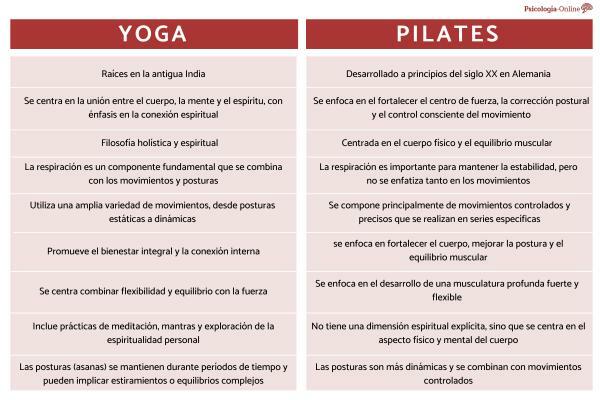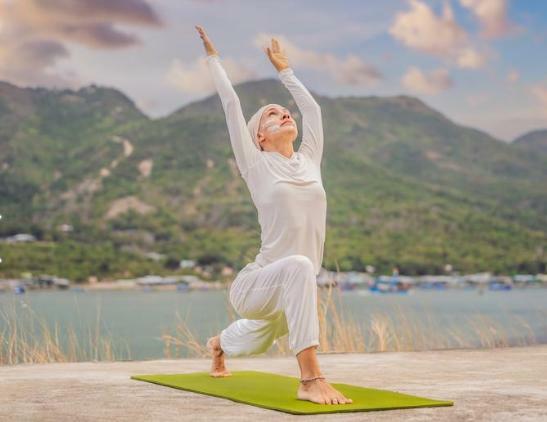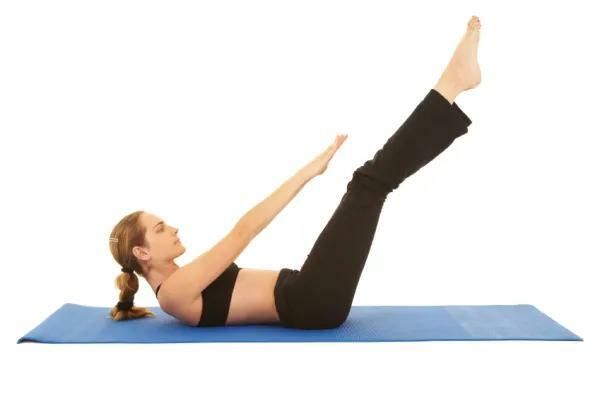
Yoga and Pilates are two practices that serve to balance the body and mind, through postures and breathing. Although they are different disciplines, there are people who confuse them, the reality is that they have different keys. For anyone who has never tried these practices
For anyone who has never tried these practices, it is normal that both seem similar, since they seek to improve flexibility, strength and attention in the "here and now." Whether you are curious or want to decide between one of the two, in this Psychology-Online article, we explain what is the difference between yoga and Pilates to dispel the myths around these exercises.
Yoga is a practice originating in India that is 5,000 years old. Since ancient times it has been performed not only as a sport, but as a holistic and comprehensive lifestyle. The term "yoga" comes from the Sanskrit word "yuj", which means "to unite" or "to integrate."
This discipline combines different elements, such as physical postures (asanas), breathing techniques (pranayama), meditation, deep relaxation, and ethical and philosophical principles. Through regular yoga practice
There are different Types of yoga, which differ in focus, whether meditative, full relationship, etc. Broadly speaking, the main characteristics of yoga are the following:
- Improves flexibility and strength: These types of exercises help develop flexibility, strength and physical endurance. Through different postures and movements, muscle elongation and strengthening of specific muscle groups is worked on.
- Promotes concentration and full awareness: The practice of yoga involves focusing attention on the present moment, concentrating on breathing, bodily sensations and thoughts. This promotes concentration, mental clarity and stress reduction.
- Helps work on emotional balance: yoga includes relaxation techniques and meditation that help reduce stress, improve mood and promote calm and emotional stability.
- Establish a mind-body connection- Encourages the connection between mind and body through awareness of physical sensations, breathing and thoughts. In this way, it helps to develop greater body awareness and cultivate a more harmonious relationship with oneself.
In addition, doing it improves general health, since regular practice benefits the cardiovascular, respiratory, immune and nervous systems. Regarding their postures, each one has its own specific characteristics and benefits.

Joseph Hubertus Pilates was the creator of the discipline that bears his name at the beginning of the 20th century. In reality, this technique emerged as an alternative to help the soldiers of the First World War to overcome their back ailments, through controlled movements that benefited development muscular.
In general terms, It is a method of physical and mental training based on breathing, control, concentration, precision and flow of movements. The main characteristics of the Pilates method are:
- Need for control and precision: Pilates focuses on performing each movement with control and precision, paying attention to correct alignment and avoiding sudden and/or uncontrolled movements. The quality of the movement is worked on more than the quantity.
- The center of strength is essential: This exercise places emphasis on strengthening the «Power House» or «center of strength», which includes the abdominal, lumbar, pelvis and gluteal muscles. These muscles provide support and stability to all movements and help maintain good posture.
- Greater use of flow and fluidity: Pilates movements are performed fluidly and continuously, emphasizing the connection between one movement and another. Its objective is to seek a smooth transition, without interruptions and maintaining the grace and elegance of each one.
- Work on conscious breathing: Breathing plays a fundamental role in Pilates. It is done deeply and completely, allows greater oxygenation and facilitates greater awareness and control of the body.
Practicing Pilates helps align the spine, strengthens supporting muscles and corrects muscle imbalances to maintain optimal posture. Some examples of Pilates movements include:
- Hundred Method: consists of performing repetitive movements of the arms and legs while maintaining the Pilates position.
- Roll-Up: involves performing a controlled movement to go from lying to sitting while activating the center of force.

The main difference between yoga and Pilates is that the former has a strong spiritual aspect, while the latter focuses more on the physical part. If you want to decide on one and don't know which one, below we show you the main differences between Pilates and yoga:
- Origin: Yoga is a discipline originating in ancient India, while Pilates was developed at the beginning of the 20th century in Germany by Joseph Pilates.
- Approach: Yoga focuses on the union between body, mind and spirit, with an emphasis on spiritual connection. Pilates focuses on the body's center of strength, postural correction and conscious control of the motion.
- Philosophy: Yoga is based on a holistic and spiritual philosophy, and includes ethical principles and a healthy lifestyle. On the other hand, pilates focuses on working the well-being of the physical body and muscle balance.
- Breathing: Breathing is a fundamental component of yoga, which is combined with movements and postures. In Pilates, breathing is important to maintain stability, but there is not as much emphasis on the specific coordination of movements.
- Movements: Yoga uses a wide variety of movements, from static, dynamic poses to fluid sequences. However, Pilates is made up of controlled, precise movements performed in specific series.
- Purpose: Yoga promotes holistic well-being and internal connection, uniting the body, mind and spirit. For its part, Pilates focuses on strengthening the body, improving posture and balancing the muscles.
- Flexibility vs. strength: Yoga focuses on achieving a balance between flexibility and strength. Pilates focuses on the development of strong and flexible deep muscles.
- Spiritual component: Yoga includes meditation practices, mantras, and the exploration of personal spirituality. Pilates does not have an explicit spiritual dimension, but rather focuses on the physical and mental aspect of the body. In this article you will find information about the Mantras: what they are, what they are for and examples.
- Postures and movement: In yoga, postures (asanas) are held for certain periods of time, and may involve performing complex stretches or balancing. In pilates the postures are more dynamic and are combined with controlled movements.
- AlignmentAnother difference between yoga and Pilates is that the former pays close attention to the correct alignment of the body to obtain the maximum benefit from each posture. The second also focuses on alignment, but emphasizes strengthening the core, rather than wanting to achieve certain angles or specific alignments.
This article is merely informative, at Psychology-Online we do not have the power to make a diagnosis or recommend a treatment. We invite you to go to a psychologist to treat your particular case.


